These facilities are prone to excessive humidity because of their large size and various activities. Too much moisture can cause machinery rust, stored materials degradation, and fungi growth. Heavy-duty warehouse dehumidifiers have been explicitly developed to regulate the right amount of humidity in large-scale industrial setups. Such devices utilize modern desiccant or refrigeration technologies that provide accurate and efficient moisture control to boost effectiveness and preserve precious assets on site. Before purchasing a suitable warehouse dehumidifier, it is essential to evaluate various aspects like room measurements, moisture load, and prevailing climatic conditions to ensure reliability and efficiency.
Why Do You Need an Industrial Dehumidifier for Your Warehouse?
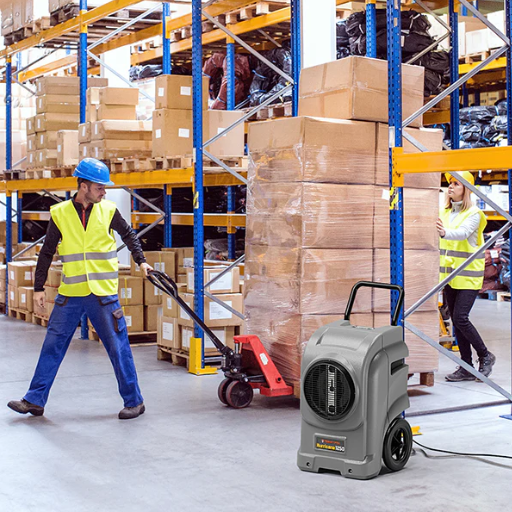
Warehouse humidity control systems are critical for maintaining the desired conditions in warehouses. Excessive air moisture may lead to problems such as mold formation, structural deterioration, or product spoilage, especially when handling delicate items like paper goods, electronics, or food staffs with limited shelf life. Using industrial dehumidification controls prevents corrosion in metal areas while protecting stockpiles from harmful spoilage agents; this maintains the recommended storage standards within the industries involved. Furthermore, they reduce accidents resulting from slippery floors caused by condensation and improve air circulation, contributing to an adequate storage facility that one can rely on throughout the year.
Understanding the Importance of Humidity Control in Warehouses
In this regard, products, infrastructure, and operational efficiency must be safeguarded with effective humidity control. Wherever there is too much moisture in the atmosphere, it may eventually result in problems such as mold growth on perishable materials or decay of metal parts. Conversely, low humidity might cause wood, paper, and textile materials to shrink or become brittle.
Industrial dehumidifiers and HVAC systems are also vital in ensuring ideal humidity levels. Such systems allow compliance with industry regulations like FDA and ISO standards relating to temperature—and moisture-controlled products. Furthermore, regulated humidity levels help avert electronic equipment malfunctions by reducing condensation, which would otherwise lead to electrical shorts or degraded performance.
This way, the controlled environment helps save energy expenses by not unnecessarily overloading cooling or heating units. Moreover, this guarantees the optimal operation of climate-sensitive machines and promotes long-term stability for warehoused goods and building members. An efficient strategy for controlling humidity safeguards warehouse assets, minimizing operational risks.
Preventing Moisture Damage and Mold Growth
To avoid moisture damage and mold infestation, I keep humidity levels confined within the facility at 30-50%, as stipulated by industry standards. To constantly maintain such humidity in check, dehumidifiers are installed in all rooms to regulate the amount of moisture. Routine checks are carried out for immediate identification and rectification of leaks or areas with condensation or high dampness. Moisture barriers are also used, while walls, ceilings, and floors have sound insulation so that water does not get into them quickly. Moreover, regular cleaning services using anti-fungal substances also prevent these from eating into the structure of the building as well as the properties stored thereof.
Maintaining Product Quality and Integrity
Maintaining product quality is a significant objective; hence, I must establish systematic protocols featuring appropriate storage technologies, environmental monitoring systems, and critical quality controls. This involves storing products under recommended conditions while continuously monitoring factors such as temperature, light exposure, and relative humidity, which affect their stability over time. Also, regular quality inspections are made to check any variances, whereas strict inventory rotation policies like First-In-First-Out (FIFO) minimize the chances of spoilage or expiry. By applying such well-established strategies, I ensure the long-lasting preservation and respectability of all items held in stock.
What Features Should You Look for in a Warehouse Dehumidifier?
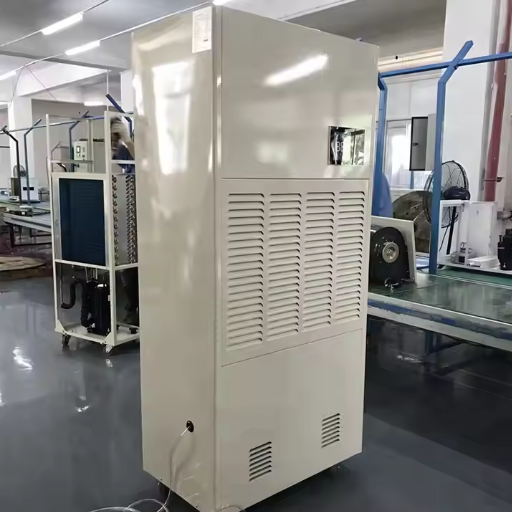
When choosing a warehouse dehumidifier, the key element should be its ability to control the required humidity level and energy consumption. Consider adjusting humidity settings to help you maintain specific environmental conditions and high-capacity moisture removal rates appropriate for your warehouse size. It’s important to note that energy efficiency is paramount as it saves money in the long run while maintaining good performance. Moreover, consider machines with muscular bodies or minimal maintenance requirements, like easy drainage options. Additional features such as integrated hygrometers, programmable timers, and environment monitors can further simplify processes and enhance operations regulation. Before buying, one must always examine whether the equipment design is compatible with available space in a given warehouse.
Large Capacity and High Moisture Removal Rate
Significant moisture removal in large-scale applications requires a high-capacity dehumidifier to work effectively. Units best serve warehouses, industrial facilities, and other expansive spaces, with over 100 pints per day removal capacities. In choosing which model to buy, prioritize continuous-rated products that perform consistently even in humid conditions. Other advanced designs may have two compressors or “desiccant technology,” which helps maintain higher extraction rates even at low temperatures. Consider energy efficiency ratings like Energy Star certification for economical operation over long periods. Ensure easy maintenance and consistent reliability in the dehumidifier’s design to meet industrial needs well.
Energy Efficiency and Operating Costs
When assessing dehumidifiers ‘ operating costs and energy efficiency, looking at energy efficiency ratings such as those shown on Energy Star-certified models is vital. These appliances use less electricity while still providing optimum performance, thus saving a lot on bills over time. Another facet I scrutinize is whether additional features like adjustable humidity controls or auto-shutoff make it possible to save power when it’s unnecessary. It’s just as important to consider how much maintenance will be required since well-maintained units tend to operate more efficiently and significantly reduce long-term expenses.
Durability and Long-Term Performance
After the build quality and materials are considered, evaluating durability and long-term performance is essential. Many products can boast high wear resistance when they contain substantial parts like corrosion-resistant metals or reinforced plastics. Moreover, models that undergo strict tests or with a guarantee for extended periods depict the highest reliability level. Keeping up with cleaning schedules and changing filters, among other regular maintenance activities, is crucial in maintaining a good performance while extending the unit’s life span. In his reviews and professional opinions, experts often bring out common malfunctions or strengths of these sorts of equipment, which can be helpful for those who intend to make wise choices about them. Therefore, users should prioritize these aspects to minimize inefficiencies and prevent premature failures from occurring.
How to Choose the Right Size Industrial Dehumidifier for Your Warehouse?

You must carefully examine some essential factors before choosing the right size of an industrial dehumidifier. At first, you should determine the total area and height of the ceiling in your warehouse, as these characteristics directly influence the air volume requiring drying. After that, a hygrometer will be used to assess the average and peak relative humidity levels in the space and calculate the necessary dehumidification capacity stated in pints or liters per day. Besides, you also need to consider things such as electronics or perishable products kept in store, which may require tight humidity control. You need to consider environmental issues such as ventilation, weather conditions outside, and moisture sources like open water or high traffic when deciding what size of dehumidifier to buy for your home. Also, check product specifications and manufacturers’ recommendations to select a unit that will serve your operational needs effectively.
Calculating the Square Footage and Volume of Your Space
When selecting equipment that best suits your specific needs, it is imperative to determine the square footage and volume of space accurately. For square footage, you will need to measure the length and width of the room in feet using a measuring tape, then multiply these two numbers together (Square Footage = Length × Width). In cases where spaces are irregularly shaped, split them into smaller regular sections, calculate the square footage for each of these small sections, and sum up the results, and this will give us the total area.
To get the volume, measure how high the room is in feet. After that, multiply this height by the square footage (Volume = Square Footage × Height). If you have spaces with different heights in their ceilings, find the volume for each part individually and add them to determine a total volume. These calculations can then establish capacity requirements that guarantee the efficient working of equipment under given conditions.
Considering Factors that Affect Humidity Levels
Considering the factors that affect humidity, I think there are three main elements. Temperature is critical because warm air can hold more moisture than cold air. Ventilation and airflow are major players in indoor humidity, controlling the exchange between moist and dry air streams. Thirdly, structural parameters like insulation or windows also matter regarding how much moisture enters or leaves any space. By manipulating these variables, it becomes possible for me to maintain specific environmental requirements by having optimum levels of humidity in a controlled manner.
Determining the Appropriate Pint Capacity
Determining the right pint capacity for a dehumidifier is done by looking at the size of the room, how severe the humidity problem is, and what environmental conditions are prevalent. A 20-30 pint dehumidifier usually does it for small rooms measuring up to 500 square feet with moderate dampness. Medium ones measuring between 500 and 1,500 square feet generally have moisture levels requiring units ranging from 30 to 50 pints. On larger areas beyond 1,500 sq.ft or where extreme dampness exists, you must have machines rated between 50-70 pints. Besides, room temperature and ventilation could also impact productivity; lower temperatures usually necessitate specific models designed for cold environments. It is crucial to adhere to guidelines provided by manufacturers and use hygrometers to make precise choices based on particular circumstances.
What Are the Different Types of Industrial Dehumidifiers Available?
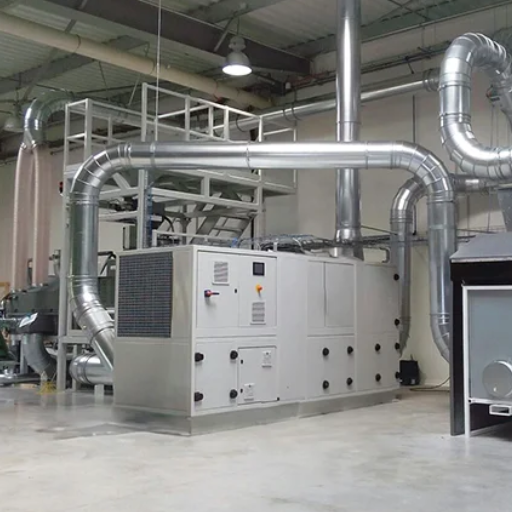
Industrial dehumidifiers are designed to handle large-scale moisture control and are generally categorized into three main types: refrigerant, desiccant, and hybrid systems.
- Refrigerant Dehumidifiers – These operate by cooling air to condense and extract moisture, making them ideal for environments with high humidity and temperatures above 50°F. They are efficient for applications such as warehouses and manufacturing facilities but may lose effectiveness in colder conditions.
- Desiccant Dehumidifiers – Utilizing a hygroscopic material to absorb moisture, desiccant models are highly effective in low-temperature and low-humidity environments. They are commonly used in cold storage or high-precision industries requiring stringent humidity control.
- Hybrid Dehumidifiers – Combining the principles of refrigerant and desiccant technologies, hybrid systems offer versatility and efficiency across diverse industrial settings. These units provide balanced performance for environments with fluctuating climatic conditions.
Each type comes with specific attributes suited to particular industrial needs, and an informed selection should consider factors such as ambient temperature, target humidity levels, and operational energy efficiency.
Refrigerant vs. Desiccant Dehumidifiers
The choice between refrigerant and desiccant dehumidifiers depends on an end-user’s specific environmental and operating requirements. Refrigerant-type dehumidifiers condense airborne humidity onto a cooling coil, making them perfect for warm climates with relative temperatures above 60°F (15.5°C). Such systems are efficient regarding energy consumption within regions of high moisture levels and often handle large airflow quantities.
Conversely, desiccant dehumidifiers employ hygroscopic material to absorb moisture, making them suitable for colder climates or applications requiring extremely low humidity levels, such as industrial drying or preservation processes. They are effective at low temperatures but usually use more energy than refrigerant systems.
The choice may be influenced by ambient temperature, target humidity level, and energy consumption. Refrigerant systems are often recommended for warm climate regions and moderate humidity control. In contrast, desiccant dehumidifiers are the better choice in cold environments that require low humidity. Each technology must match operational needs and cost implications to maximize performance.
Portable vs. Mounted Dehumidifiers
Portable dehumidifiers are suitable for flexible uses that are short-term or when one is on the move. They are easy to install, have lower up-front costs, and can be easily transferred from place to place as needed. However, they may lack the capacity and efficiency required in large-scale or continuous operations. On the contrary, mounted dehumidifiers are for permanent installations and are suitable for long-term applications with high demands. They usually work with HVAC systems to ensure better humidity control and enhanced energy use efficiency through total coverage of humidity problems over a particular space, hence requiring expert installation, which initially makes them expensive. The choice generally depends on how big the job is, how long it will last, and its peculiarities.
Dehumidifiers with Pump vs. Drain Hose Options
The difference between dehumidifiers with built-in pumps and those that accept a drain hose lies in how water is removed. With a built-in pump, dehumidifiers force collected moisture upwards and over longer distances, allowing their flexible placement since water can flow into sinks, windowsills, or other elevated points. This design works particularly well in basements or other areas where gravity does not allow drainage.
Moreover, gravity-based hoses are used in typical drain models to empty the water into a nearby drainage system or sump pump. These dehumidifiers are more manageable and often cheaper and only require that they are positioned close to the right place with good drainage, such as a floor drain. Site conditions and layout considerations influence the selection between the two; dehumidifiers with pumps may be appropriate where access to adequate drainage is limited, while those relying on gravity drains are suitable for spaces equipped with regular floor drains and other similar outlets. It should be noted that these alternatives maintain optimum humidity levels. Hence, their suitability depends on how well they can meet specific logistical functions required for an application.
How to Properly Install and Maintain Your Warehouse Dehumidifier?
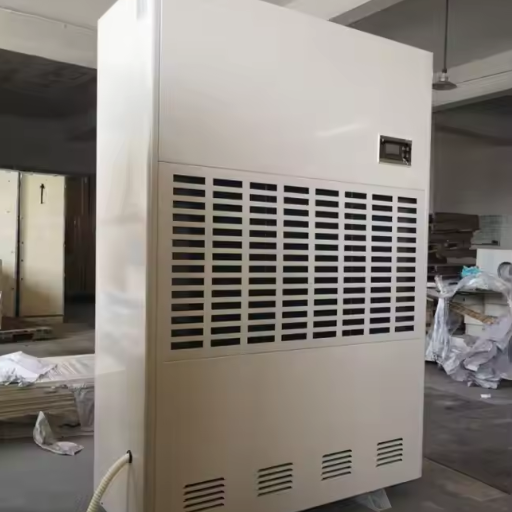
Part one: It is essential to select an appropriate place for the appliance to work well. Consequently, I locate the correct position for a dehumidifier while considering whether there is adequate airflow and its proximity to a drainage point. Second step: During installation, I will ensure that the unit is level and that pump or gravity drainage hoses are securely attached and positioned to prevent leaks or backups. Thirdly, cleaning or replacing air filters monthly to maintain airflow efficiency and checking the drain system for clogs or damages, among others, would be part of my routine check. Lastly, For these reasons, I occasionally inspect the coils of my air conditioning system for ice formation or dirt accruals, which may hinder its proper functioning. This way, the device can continue functioning correctly and have a long life span.
Optimal Placement for Maximum Efficiency
The placement of HVAC units proves critical regarding their effectiveness and output. Ideally, the location should have high airflow and no obstructions, such as walls, shrubs, or furniture, that can hinder air movement. Outside ones should be placed on level ground with slightly elevated sides to prevent water from pooling, and shaded places should be put in so that less direct sunlight will deter electricity consumption. Placing indoor units centrally within a building improves the uniform distribution of airflow. It is crucial not to position them near heat-emitting appliances or rooms since this could lead to poorly maintained temperature levels and the system operating under undue stress. Proper positioning and spacing increase energy efficiency and minimize the rate at which it wears down, thereby prolonging its life.
Regular Maintenance and Cleaning Tips
Regular maintenance and cleaning are essential to achieve optimal performance and longevity of your HVAC system. To maintain airflow and improve air quality, the filters should be cleaned or replaced every 1-3 months. Prevent dirt buildup on the evaporator and condenser coils by checking them regularly because this could affect efficiency. Ensure that the outdoor unit is debris-free, leaving a space of at least two feet around it to enable proper airflow. Also, annually consult with an expert to inspect refrigerant levels and various system parts, such as compressors, for glitches. Such simple steps can significantly increase efficiency and reduce the chances of expensive repairs happening.
Troubleshooting Common Issues
When addressing common HVAC issues, I identify symptoms and work through logical steps toward the problem. If the system does not cool or heat well, I ensure the thermostat settings are appropriately programmed and operational. After that, I will check the filters for any clogs or dirt buildup, as this restricts airflow and thus reduces efficiency. In case the unit cycles on and off frequently, I can find troubleshooting options such as dirty condenser coils, low refrigerant levels, or a malfunctioning thermostat. When a unit fails to start up at all, first, I look at the circuit breaker to see if it is tripped, and then I check to see if there is power coming into the system. Using these approaches in an ordered manner, many HVAC problems can be resolved without engaging professionals. Still, when complex matters such as electrical problems or refrigerant leaks arise, one must swiftly meet an experienced technician.
What Are the Top Industrial Dehumidifier Brands for Warehouses?
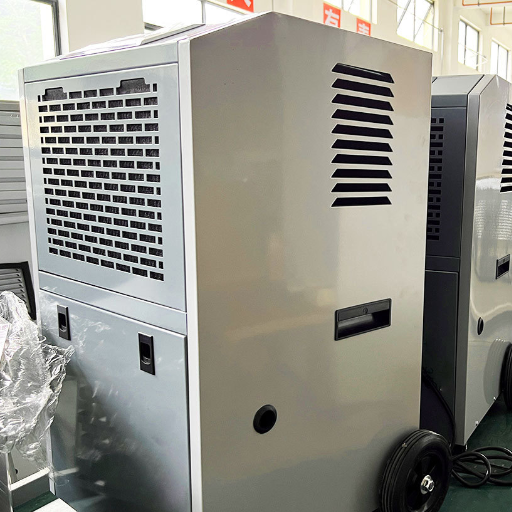
Several leading brands stand out when selecting an industrial dehumidifier for warehouses because of their reliability, efficiency, and advanced features.
- Aprilaire – Known for their durable and high-capacity units, Aprilaire dehumidifiers are ideal for maintaining consistent humidity levels in large spaces.
- Quest – Quest offers energy-efficient models with robust moisture removal rates, making them a top choice for warehouses with demanding requirements.
- Ebac – With a reputation for rugged design, Ebac dehumidifiers perform exceptionally well in challenging and high-humidity environments.
- Dantherm – Dantherm specializes in innovative and customizable solutions for various industrial applications.
- Fral – Fral provides versatile units that deliver consistent results while being easy to install and maintain.
Each brand is widely recognized for delivering quality performance, ensuring your warehouse remains safe from excess moisture and associated risks.
Comparing Leading Manufacturers and Models
When comparing major manufacturers and models, it is necessary to assess their performance, reliability, and appropriateness for particular industrial settings. Meaco beats other companies due to its energy-saving dehumidifiers that remove moisture, ideally resulting in cost-saving features suitable for permanent store use. In contrast, Ebac is built with strength in mind and can withstand harsh weather conditions, hence having robust machines that are able to fight against persistent humidity as required by high-capacity areas. Lastly, Dantherm is the best brand for customized industrial applications, and its products have the highest level of versatility regarding special operational needs. The selection of the right producer primarily depends on certain factors such as power-efficient design, long-lasting performance, or bespoke setup.
Customer Reviews and Ratings
Meaco stood out while reviewing leading industrial dehumidifiers because of its energy efficiency; buyers appreciate how this saves money over time. On the other hand, Ebac is consistently praised for its strong construction and reliable performance under demanding circumstances—such as warehouses or manufacturing plants. Likewise, Dantherm got its name by being agile and having specific solutions that effectively meet operational needs. Overall, though all these three brands enjoy a good reputation, they would only fit into different requirements and priorities based on operations carried out by individuals who use them.
How Can Industrial Dehumidifiers Benefit Other Commercial Spaces?
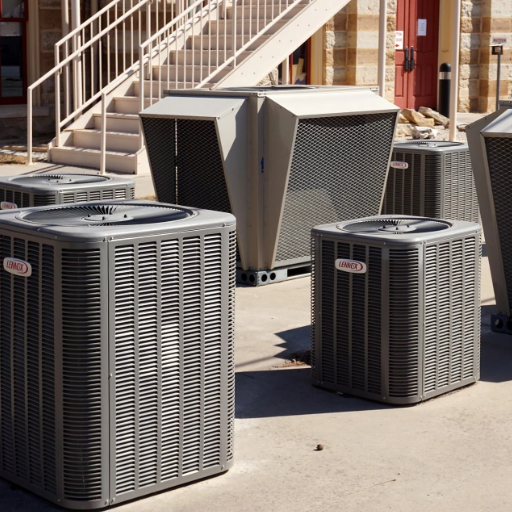
There are many commercial environments where industrial dehumidifiers can be used to maintain the correct humidity levels. They help protect stock from dampness and mold, preserving it longer in retail situations. Besides, office buildings have fresh airflows and fewer problems with humidity-related health risks, leading to healthier workplaces. Museums and archives depend on these appliances to preserve their collections of fragile materials like paper documents and artworks that would deteriorate due to excess moisture. Dehumidifiers also contribute to making hospitality places have a more comfortable environment without smells around the rooms where guests rest. In conclusion, these devices are multi-purpose equipment that support work efficiency while preserving assets across business scopes.
Applications in Basements and Crawl Spaces
Basements and crawl spaces exhibit the highest humidity levels due to their location and insufficient air movement, which can cause mold, mildew, dry rot, or even building collapse. In such spaces, there is a need for industrial dehumidifiers that effectively remove moisture, thus preventing the growth of harmful microorganisms while keeping building materials intact. They also help improve indoor air quality by reducing airborne particles caused by excessive humidity and odors. This creates an unfavorable environment for pests like insects and rodents, thus minimizing infestation through humidifiers in crawl spaces. With industrial-grade dehumidifiers, property owners can prolong the life span of these areas while eliminating the risk of expensive restoration.
Use in Water Damage Restoration Projects
During water damage restorations, industrial dehumidifiers are invaluable tools. They speed up this process by removing excess moisture from the air and affected items, preventing secondary damages like molding and diminishing strength structures. Such machines are designed to efficiently handle cases involving large amounts of water invasion, hence ensuring quick reinstatement of safe living conditions in these areas. Through their high power capacities coupled with advanced technology, industrial dehumidifiers become essential in averting long-term destructions while shortening repair time frames after incidents.
Benefits for Grow Rooms and Agricultural Facilities
Industrial dehumidifiers are necessary for achieving optimal humidity levels in grow rooms and agricultural settings; they are essential for plant health and yield because precise environmental control is required. Excessive moisture causes mold, mildew, or fungal diseases, which can destroy crops. In addition, it makes conditions more stable so that photosynthesis takes place while nutrients are absorbed, thus improving the productivity and quality of the end product. Moreover, high-capacity dehumidifiers lower energy consumption by reducing strain on cooling systems, ensuring reliable airflow and temperature control. Industrial dehumidifiers also help protect bulk storage of farm produce like grains from damage caused by fluctuating humidity levels, securing investments and avoiding wastage. With their dependability and sophistication in design, such machines contribute to attaining sustainable farming practices laden with efficiency.
References
Frequently Asked Questions (FAQ)
Q: What are the benefits of using industrial commercial warehouse dehumidifiers?
A: Industrial, commercial warehouse dehumidifiers offer heavy-duty moisture control for large spaces. They provide efficient dehumidification, reducing condensation and maintaining optimal relative humidity levels. These units are designed for industrial use, protecting inventory, equipment, and structural integrity in warehouses, basements, and other commercial spaces.
Q: How do commercial dehumidifiers with pumps work?
A: Commercial dehumidifiers with pumps are designed to remove moisture from the air and automatically expel collected water. The pump feature allows for continuous drainage, eliminating manual emptying. This makes them ideal for basements, warehouses, and other areas requiring constant dehumidification.
Q: What size dehumidifier do I need for an ample industrial space?
A: You’ll need a heavy-duty, high-capacity unit for large industrial spaces. Large industrial dehumidifiers are typically measured in pints of water removed per day. Your size depends on your space’s square footage and humidity levels. For expansive warehouses, you might require multiple units or a large industrial dehumidifier with a capacity of 100 pints or more per day.
Q: Are portable dehumidifiers suitable for commercial or industrial use?
A: While portable dehumidifiers are convenient, they are generally unsuitable for large-scale commercial or industrial use. Industrial and commercial spaces typically require more robust, stationary units for continuous operation and higher moisture removal capacity. However, portable units can be helpful for smaller areas or temporary dehumidification needs.
Q: What is the advantage of using a dehumidifier with a drain hose for basements?
A: A dehumidifier with a drain hose for basements offers continuous operation without requiring frequent manual emptying. This feature is handy in areas with high moisture levels, such as basements. The drain hose allows for automatic water removal, making the dehumidification process more efficient and reducing the risk of water damage.
Q: How can industrial dehumidifiers help with water damage restoration?
A: Industrial dehumidifiers play a crucial role in water damage restoration by quickly removing excess moisture from the air and materials. These powerful units can significantly speed up drying, preventing mold growth and further structural damage. Water damage restoration dehumidifiers are designed to operate in extreme conditions and can handle large-scale moisture removal efficiently.
Q: What features should I look for in a professional dehumidifier for commercial use?
A: When selecting a professional dehumidifier for commercial use, look for features such as high moisture removal capacity, energy efficiency (like Energy Star certification), durability for continuous operation, automatic pump for water removal, and precise humidity control. Additional features might include digital displays, programmable settings, and compatibility with ducted systems for larger spaces.
Q: How do ducted dehumidifiers differ from standalone units?
A: Ducted dehumidifiers are integrated into a building’s HVAC system, allowing for centralized humidity control throughout multiple rooms or large spaces. Unlike standalone units, ducted dehumidifiers can simultaneously treat air in various areas, making them ideal for expansive industrial or commercial settings. They offer more discreet operation and can be more energy-efficient for controlling humidity in large areas.



